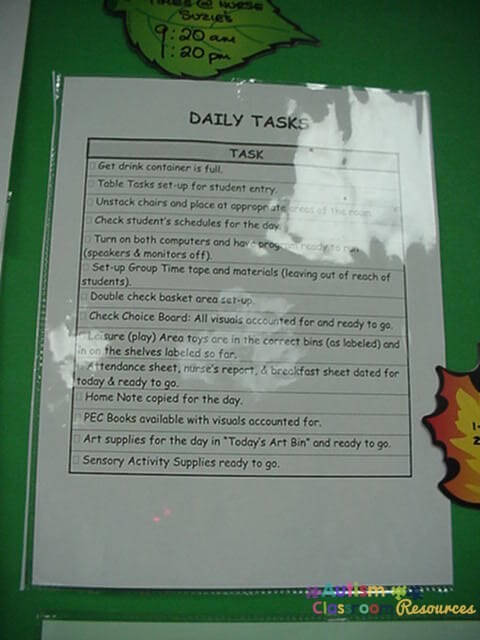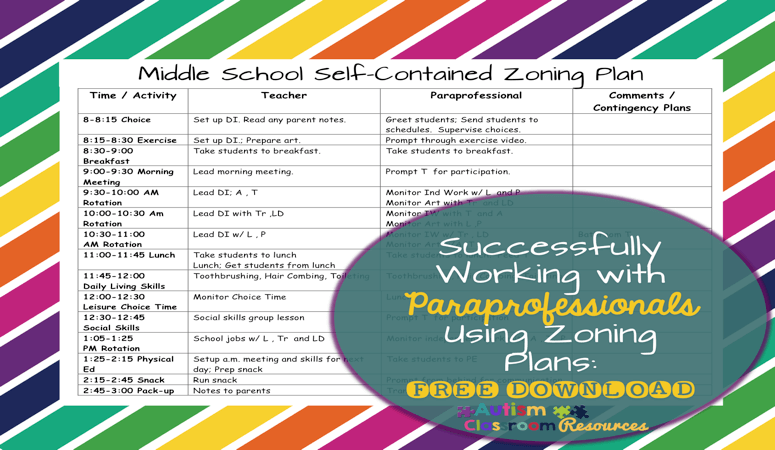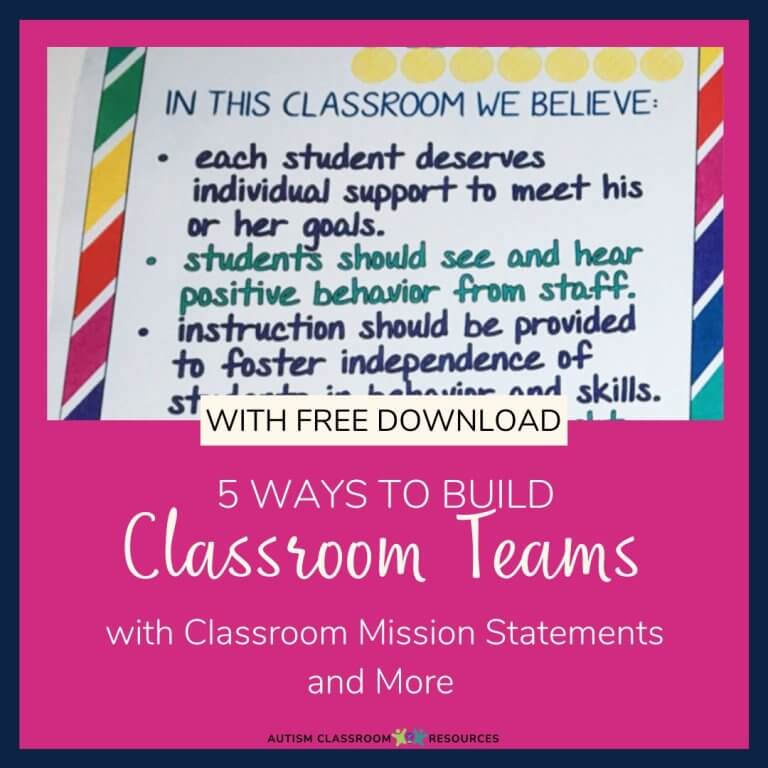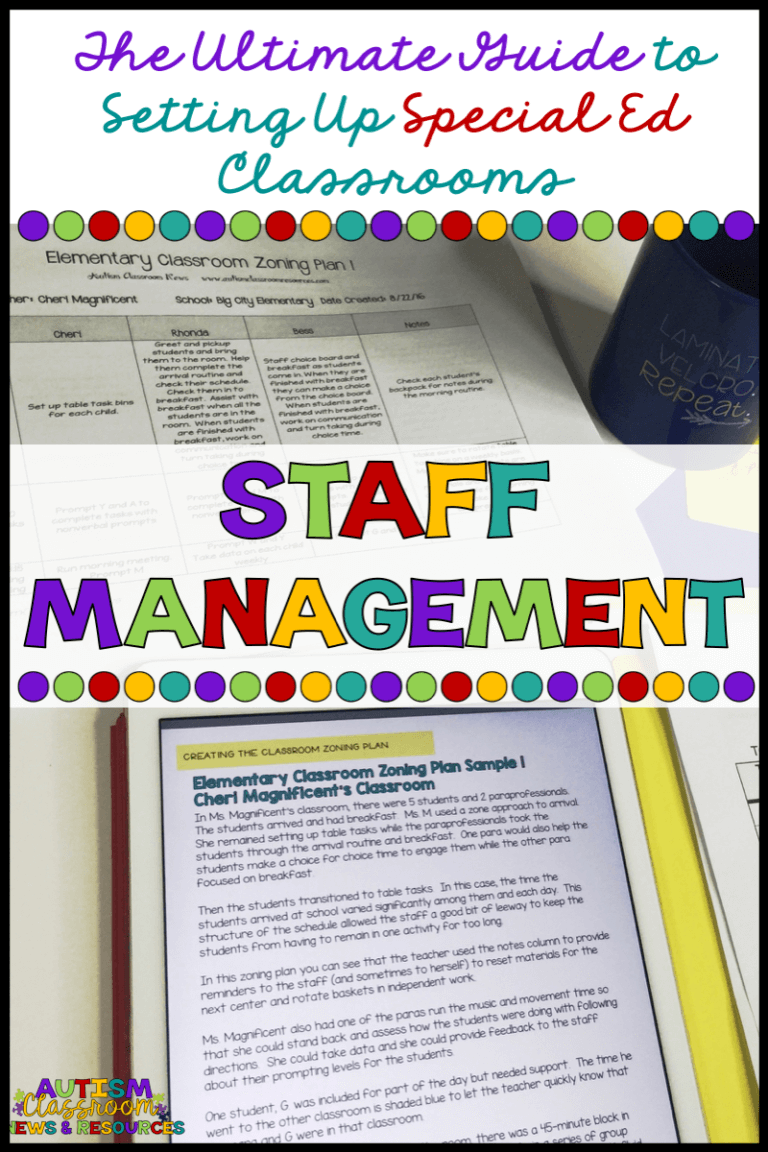Sharing is caring!
Working with paraprofessionals is always a hot topic for special educators. Let’s face it, the classroom work environment isn’t like other work environments. Teachers aren’t typically the administrative supervisors of the paraprofessionals so there isn’t a traditional “chain of command” and yet teachers are responsible for the outcome of all the staff’s work in the classroom. Teachers and paraprofessionals can’t go “back to their office” after a discussion. You live together 6 to 8 hours per day. And most of the time that classroom staff are together, they have to be “on” for the students. There is little time for collaboration, discussion, chit chat, or even just downtime together. To address this, I want to share some strategies I’ve found useful over the years to help all the educators in the classroom work together peacefully and productively.
 Zoning Plans
Zoning Plans
First, take the time at the beginning of the year to create a zoning plan. I have talked about zoning plans here, here and here. There is even a blank zoning plan form freebie available in this post. A zoning plan is essentially a schedule for the staff. It includes all the staff, including the duties of the teacher. It takes time to put it together. It takes even more time to talk with the staff about what works for everyone in the schedule. However, taking the time to schedule it out, talk about it, problem solve when there are differences, and determining what everyone is comfortable doing goes a long way to starting the year off right. The focus of a zoning plan is to automate how the classroom runs so that less time can be spent directing staff, leaving more time for engaging students. You can set it up as a man-to-man plan where each staff member is responsible for 1 or a small group of students. You can also set it up as a true zone where one person is responsible for any child in his/her area. So, if I’m in art, I’m responsible for engaging all the students in art. Which you decide depends on how many staff you have and the needs of your students. This post provides some good ideas about why a zoning plan is important. This post focuses on 10 things to remember to zone (like who resets the schedule, who takes the walkie-talking on community outings). And finally this post focuses on some tips for how to make it work easily in the room. Each one includes zoning plans of different grades and levels as well (that you can download below for reference later). In addition, you can read my post about zoning plans in secondary life skills classrooms on A Special Sparkle here.
Schedule Breaks
Second, make sure to include at least 15 minute breaks into the zoning plan. This is covered in the posts linked above, but I think it bears repeating. So many times I hear teachers say, “I don’t need to take a break” or “my paras don’t get breaks.” OK, we want students to be engaged throughout the day, right? We also want to try to avoid people being on mobile phones, texting, emails etc. because if they are doing that, they aren’t engaged with the students, right? Both of these are much more likely to occur if you never have a chance to step away. The break doesn’t have to be out of the room and it needs to be planned for in the day, but if you don’t plan for breaks, they will occur when staff is supposed to be with the students. They may not physically leave, but we will all take mental breaks if we don’t have a designated time for them. So, give ’em (and yourself) a break and schedule them in. Trust me….it’s easier that way in the long run.
Collaborate

After you develop your zoning plan, set up an established time to talk with the staff and get their input on how things are going, solving problems, and sharing information like data and plans. I know that time for collaborating with staff is getting harder and harder to find. Perhaps there is one time each week when the teacher next door will take bus duty for your aides if you take bus duty for her aides another day. Then you can each use the time when the paras don’t have bus duty to meet with them. Get creative with your time. If there is absolutely no time to collaborate verbally, print out things like behavior plans and data summaries so that the paraprofessionals can see how the data they are taking influence what happens in the classroom.
Visuals
Finally, remember that visuals are not just for our students. Using individual and/or group schedules with the students keep the adults on track about what comes next. Give visual reminders in the area to help all the adults know who is coming through their center next, what reinforcers will be effective with which students, and what strategies to use. Visual reminders are a good way to remind all of us about steps in a task to use, the need to wait for a student to try something on his or her own, and what prompting strategies to use. The discrete trial flow charts I shared in my last post are one type of visual support. I’ll be coming out with some more in the next week or so, so stay tuned. And if you have particular visual supports for adults that you would like to see, please share them in the comments and I’ll do my best to include them.
Looking for more resources for setting up a classroom for students in special education, check out book Setting up Classroom Spaces.
Disclosure: this is an affiliate link that costs the same for you but pays me a small amount for sending you to Amazon. 🙂
So, here you can download some zoning plans as examples to follow. And be sure to hop over to The Organized Planbook to gather more ideas about how to successfully work with paraprofessionals.
And come back tomorrow for some more exciting back to school ideas and resources…Until then,










